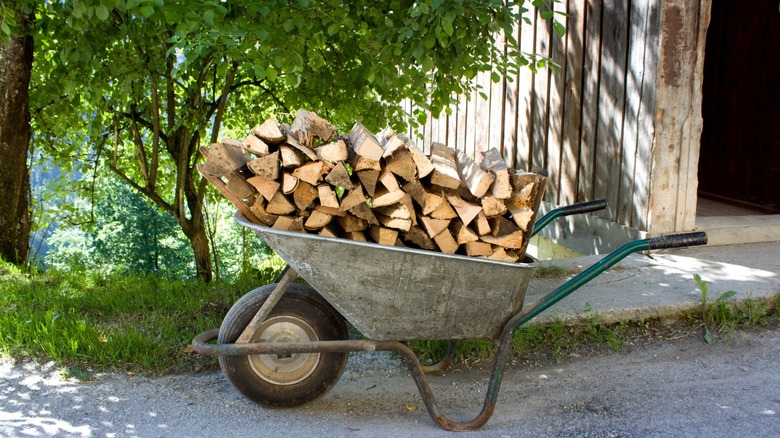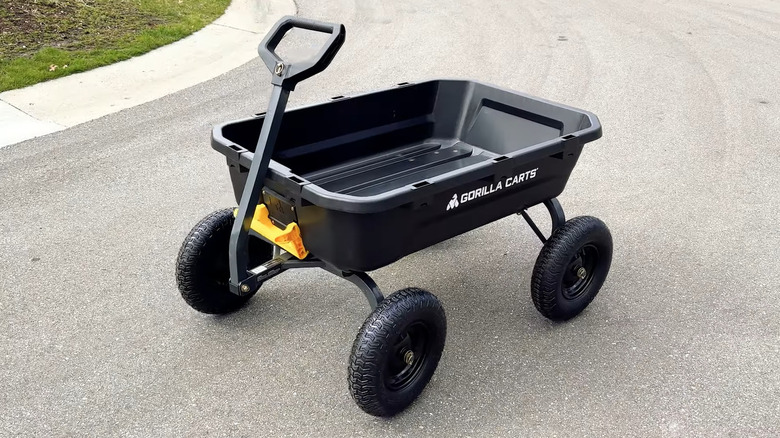3 Types Of Wheelbarrows In Your Garden (& What They Work Best For)
We may receive a commission on purchases made from links.
Moving anything from point A to point B in your garden can be a monumental task. A little help is always welcome, and a reliable wheelbarrow can be just the tool you need. Whether you want a basic do-it-all wheelbarrow or something that can do more of the heavy lifting, there's a wheelbarrow for the job.
Thankfully, it's not difficult to choose the perfect wheelbarrow for gardening. The average home gardener really only has three options: a traditional wheelbarrow, a garden cart, or a motorized wheelbarrow. All three types of wheelbarrow will haul items in your yard, but picking the right one for your needs — and your budget — is key to making your life easier and gardening more fun.
Let's start with traditional wheelbarrows, as seen in the image above. These feature a wheel or two in the front with two metal legs and handles. A pan or tray makes up the body. A traditional wheelbarrow is usually used for hauling leaves, mulch, dirt, gravel, and more around the garden. The material is shoveled out or tipped out onto the ground by upending the tray. There are all kinds of variations on the traditional wheelbarrow. Some have pneumatic, solid, or puncture-proof tires and carry small or large loads. Others feature one or two wheels and trays made of plastic, iron, or galvanized steel. Consider which tasks you need a wheelbarrow for when choosing one to buy, as well as the downsides of this type of wheelbarrow: for example, traditional one-wheeled wheelbarrows can tip over sideways if they're handled improperly. A helpful way to make gardening simpler for older people is to choose a more stable two-wheeled barrow. Prices range from about $25 for a 30-inch-long LuckyNote Metal Wheelbarrow to over $1,700 for a Qiupai Double-Wheel Thickened Build Wheelbarrow.
Beyond the traditional wheelbarrow: Meet garden carts
If your garden is large or has patches of uneven ground, a traditional wheelbarrow isn't going to cut it. A garden cart has four wheels instead of the one or two of its classic cousin. The tray has straight walls and a flat base. Essentially, a garden cart resembles a much sturdier child's wagon in design.
Most carts have rugged wheels for traversing bumpy lawns. They can be made completely out of metal or may have a canvas liner. A garden cart is an essential landscaping tool to keep nearby when working in your backyard, especially if you frequently haul landscaping tools or materials. Instead of pushing heavy loads in front of you, you can pull them behind you, which is typically easier. That said, not everyone will have the strength to pull a fully loaded 1,200-pound Gorilla Carts Steel Utility Cart. If that's you, opt for something smaller and lighter, like the 220-pound Yesker Foldable Wagon.
For an energized option, look at motorized wheelbarrows
If you regularly move really heavy loads or your backyard is full of slopes, you might want to consider something that won't be quite so heavy to push. In that case, consider looking into a motorized or electric wheelbarrow. Electric wheelbarrows look similar to traditional wheelbarrows, but they're fitted with a motor.
Motorized wheelbarrows can reduce physical strain and increase hauling efficiency. That said, they tend to be more expensive, for obvious reasons. Prices start at around $400 for a 330-pound VEVOR Electric Wheelbarrow Cart and can get into the thousands for more heavy-duty machines. They're most frequently used by professional landscapers and construction workers who work on large lots. For the average gardener tending their flower beds or vegetable garden, the latter two options — a traditional wheelbarrow or a garden cart — are probably a better investment, but if you do need something heavy duty or have a physical condition that makes it difficult to push one of the other two options, it's good to know that electric motorized wheelbarrows exist.


